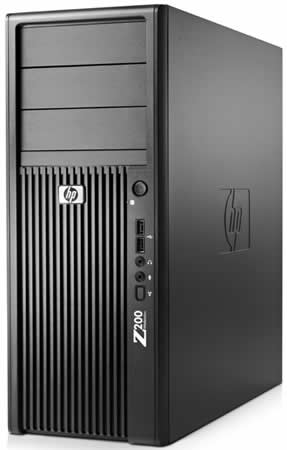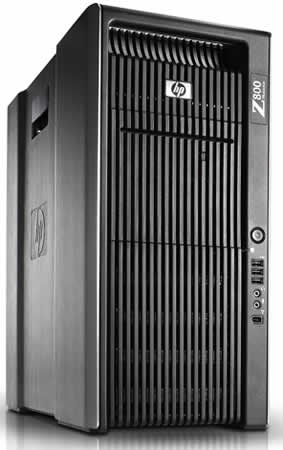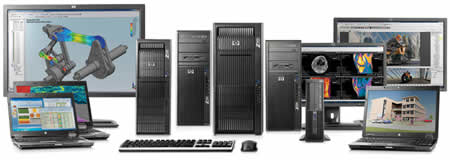 To learn more about HP Workstations and what they offer to film editors, we had an interview with Travis Humphries is a product marketing manager for the HP Workstations Global Business Unit in Fort Collins, CO. Travis is responsible for the feature definition and lifecycle management of HP Performance Workstations; the current generation of this product is the HP Z400 Workstation. Having developed a proclivity for computer technology while working part-time repairing servers and PCs during his undergraduate years, Travis was always attracted to the reputation and global presence of Hewlett-Packard. Putting this into practice, he secured a position with HP as an outbound marketing and pricing specialist for HP Workstations. This work included developing promotional programs, product definition, sales support, and various business development activities. Eventually, he was able to parlay this work into his current position.
To learn more about HP Workstations and what they offer to film editors, we had an interview with Travis Humphries is a product marketing manager for the HP Workstations Global Business Unit in Fort Collins, CO. Travis is responsible for the feature definition and lifecycle management of HP Performance Workstations; the current generation of this product is the HP Z400 Workstation. Having developed a proclivity for computer technology while working part-time repairing servers and PCs during his undergraduate years, Travis was always attracted to the reputation and global presence of Hewlett-Packard. Putting this into practice, he secured a position with HP as an outbound marketing and pricing specialist for HP Workstations. This work included developing promotional programs, product definition, sales support, and various business development activities. Eventually, he was able to parlay this work into his current position.
Travis is a Summa Cum Laude graduate of Texas A&M University and holds a Master of Science in Marketing from Mays Business School. A native Texan, he currently lives in Fort Collins, CO with his wife and three dogs. In his spare time, he enjoys golfing, fishing, and working on computers.
Bijan Tehrani: Can you tell us about HP Z Workstations in terms of how they apply to video editing? Also, can you discuss some relevant innovations since this portfolio launched in 2009?
Travis Humphries: HP Workstations have implemented some very notable innovations since first releasing the HP Z Workstation portfolio. These technology changes help HP dramatically advance system performance and really help improve the video editing work flow. One example of innovation is HP’s updated professional graphics card offering, which maximizes the performance of the digital video editing applications and helps minimize the time needed to go through the typical work flow. Examples of our updated professional graphics include the NVIDIA Quadro 600, 2000, 4000, 5000, and 6000.
Another example of HP Z Workstation innovation specific to the HP Z400 Workstation is the introduction of an optional higher-capacity (600W) power supply to further increase this platform’s graphics expandability. In fact,  offering this higher-capacity power supply allowed NVIDIA to test and certify their high-end professional 3D card, the Quadro 6000, on the HP Z400 Workstation, thereby permitting extreme graphics performance in a more affordable package.
offering this higher-capacity power supply allowed NVIDIA to test and certify their high-end professional 3D card, the Quadro 6000, on the HP Z400 Workstation, thereby permitting extreme graphics performance in a more affordable package.
Another significant example of innovation is the addition of higher-performance, higher-capacity storage drives, which considerably increase read and write times versus traditional hard disk drives. The additions include 160GB enterprise-class solid-state drives, 600GB SATA 10k RPM hard disk drives, and 600GB SAS 15k RPM hard disk drives. What these higher performance, higher capacity storage options do for digital video editors is allow them to store their large files locally on their workstations and access and use the files as fast as possible, further reducing the time to completion for video editing projects.
My final example of recent HP Workstations innovation is the introduction of Intel “Westmere” processors, signifying a progression in Intel process technology, and allowing a greater numbers of cores and higher clock speeds. Before this introduction, a single-processor workstation was limited to a maximum of four physical cores; afterward, the maximum expanded to six cores, a 50% increase. Couple this with even higher clock speeds, and users can see very impressive increases in system performance. More specifically, in terms of digital video editing, which uses applications that take advantage of all available processor cores, users can see an almost linear positive effect on performance.
BT: Considering acoustics, has HP Workstations made any improvements the physical box?
TH: HP understands that acoustics is a high priority for workstation users, who typically spend large amounts of time running demanding applications at their desk side. This is especially relevant when considering movie editing studios that may have several users in one room together. In fact, the HP Workstations group has R&D labs dedicated to the purpose of acoustic improvements. Because of this, users see real improvements to system acoustics on every generation of workstations. More specifically, the improved industrial design included in the launch of the HP Z Workstations line demonstrated one of the greatest generation-to-generation improvements yet. Additionally, for even more impressive acoustic reduction, HP Workstations offer liquid cooling solutions to more effectively remove heat from inside the system by eliminating the CPU cooling fan and replacing it with a cold plate and radiator system that vents air directly out of the rear of the system. The reduced internal ambient temperature also allows the other fans within the system to run at a slower, quieter speed. All of these acoustic improvements allow for a quieter workspace and less user fatigue over the course of project completion.
 BT: What is the price range of the systems when compared to the previous generation?
BT: What is the price range of the systems when compared to the previous generation?
TH: Comparing prices from generation-to-generation is not very straightforward due to all of the advancements and technologies that come with any new generation of workstations. However, users should recognize better price/performance with the new generation relative to the amount spent. With a starting price below $1,000, the HP Z400 Workstation delivers a high-performance workstation at a compelling value.
BT: What are some of the higher end models that you can talk about?
TH: HP Workstations work to meet many different customer needs across several market segments. Because of this, we deliver an entire portfolio of products to best match up to these needs. Our entry platform is the HP Z200 Workstation, which includes two different form factors and true workstation technologies at PC-like prices. The HP Z400 Workstation is HP’s performance platform and delivers incredible single-processor workstation performance at an affordable price. For video editing, this is the platform of choice when working on entry- to medium-sized projects. If doing more advanced editing, users should consider one of HP’s two dual-processor workstations, either our mid-range platform, the HP Z600 Workstation, or our extreme platform, the HP Z800 Workstation. The HP Z800 Workstation offers the ultimate in performance and expandability to tackle the most complex and demanding video editing projects.
BT: How has the new generation improved in terms of compatibility with editing software?
TH: HP Workstations have, for several generations, worked closely with different independent software vendors, such as Adobe, to ensure our workstations are certified on various applications, such as Premiere Pro and After Effects. This way, users can be confident that the applications they are choosing to run are guaranteed to work as well as they should and will be supported by both HP and the software vendor. Additionally, there are specific hardware improvements, as mentioned earlier, that allow editing applications to maximize performance on HP Workstations. For example, Adobe Premiere Pro is designed to take full advantage  of the parallel processing technologies available in our NVIDIA Quadro professional graphics cards. Another example of how HP Workstations allow users to get the most out of their applications is through our proprietary HP Performance Advisor software, included on all new systems at no additional cost and designed for non-technical consumers to use and understand. With just a few clicks of the mouse, users can view detailed information on how applications are using processing and memory capacity and whether or not they have optimum drivers installed. With this information, users can cleanly configure maximum performance requirements for specific applications so they can spend more time working, processing, and editing and less time troubleshooting their application. These and other technologies included in HP Workstations can help users transform their entire video editing workflow.
of the parallel processing technologies available in our NVIDIA Quadro professional graphics cards. Another example of how HP Workstations allow users to get the most out of their applications is through our proprietary HP Performance Advisor software, included on all new systems at no additional cost and designed for non-technical consumers to use and understand. With just a few clicks of the mouse, users can view detailed information on how applications are using processing and memory capacity and whether or not they have optimum drivers installed. With this information, users can cleanly configure maximum performance requirements for specific applications so they can spend more time working, processing, and editing and less time troubleshooting their application. These and other technologies included in HP Workstations can help users transform their entire video editing workflow.
BT: What can we expect to see in the future for the Z400, or next generation products?
TH: If you look at the history of HP Workstations, you can see that we strive to be leaders in bringing new technologies to market as they are released by the different technology companies. More specifically, HP Workstations, which utilize Intel Xeon processors, typically introduce new generations of products as Intel introduces new and improved processor architectures. By doing this, HP Workstations deliver some of the most advanced and highest-performing technologies available on the market.

